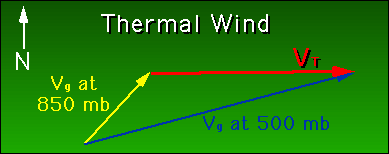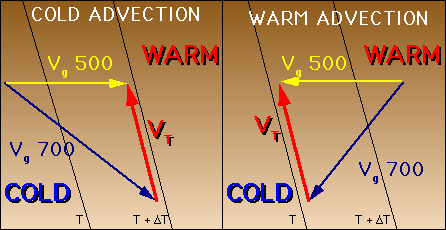|
|
Thermal WindBecause pressure changes with height, the horizontal pressure gradient also changes with height. Therefore, the geostrophic wind is not constant with height, as it changes with the pressure gradient. For example, let's say Vg at 850 mb (85 kPa) is from 220° at 30 kts (35 mph). Vg at 500 mb (50 kPa) is from 255° at 60 kts (69 mph). The change of wind, in both magnitude and/or direction, with height is known as vertical wind shear. The change in the geostrophic wind with height is known as the thermal wind (VT) Here, VT is approximately from the west.
 The thermal wind is expressed simply as the geostrophic wind for the upper level minus the geostrophic wind for the lower level. Remember, pressure decreases as you go up, so in our example, the upper Vg is at the 500 mb (50 kPa) level, and the lower at the 850 mb (85 kPa) level. What is the significance of the thermal wind? It is a good way of showing temperature advection. Remember, advection is horizontal temperature transfer. Geostrophic wind in the Northern Hemisphere has higher pressure values to the right of the direction of Vg and lower pressure values on the left. Similarly, the thermal wind has higher values to the right of the direction of VT and lower values on the left, only in this case the values are temperature, not pressure. Therefore it is possible to determine whether cold or warm advection is occurring.
 Notice above that in the case of cold advection, the geostrophic wind backs with height, i.e its direction shifts counter-clockwise. For warm advection, the wind veers with height, or shifts clockwise. Logically, a large thermal wind means there is a tight thermal gradient, the best examples of which occur at a frontal zone.
Confused? Have a question? If so, check out the Frequently Asked Questions (FAQ) page or send mail to the OS411 tutor (os411tutor@shodor.org) with your question! Report technical/content problems here |
|
|